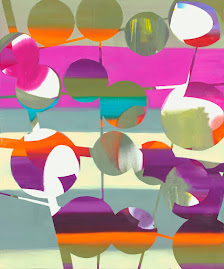 |
| The New Natural, oil and acrylic ink on pieced and sewn muslin, 2021 |
During a recent talk at her exhibition in the main gallery
of
The Arts Center of the Capital Region in Troy, the painter Gina Occhiogrosso
discussed the dichotomy of pessimism and optimism. “Most of my friends would
say I’m pretty negative,” she said, while surrounded by a room full of her
buoyantly colorful abstract works, effectively silencing that notion.
We are living in a time when it seems impossible to be
hopeful – yet that is in a sense our only
hope. Occhiogrosso understands this, and while her artistic practice remains
primarily a rigorous pursuit of the purely visual, with regular forays into the
topical (examples include feminism, global warming, and the pandemic), the results
are clearly meant to uplift.
 |
Migration, acrylic paint and ink
on sewn cotton, 2017 |
This exhibition, entitled
Surfacing, is her first solo in the region in about 15 years, and
it represents a sort of homecoming – for five years in the early 2000s, Occhiogrosso
was the director of this gallery, and she spoke of having dreamed of one day
showing there herself. Dream fulfilled, the nearly three-dozen works in this display are a
comfortable fit, with a few very large colorful installations on the biggest
walls in the back, a couple of much more intimate pieces set up on pedestals in
the middle of the space, and paintings ranging from modest to grand in scale
arrayed on the walls and columns.
Not a retrospective, Surfacing
is comprised mainly of recent works, and seems to want to be about
re-emerging from the isolation of the pandemic. If so, then it reveals a rather
glorious private world of shimmering shapes and radiant colors – hardly the
doom and gloom one might expect from an artist stuck inside for a couple of years.
 |
Cascade, oil and acrylic
on pieced and sewn polyester, 2019 |
A few earlier works show how Occhiogrosso moved into her current style, and a few works - such as the two pedestal-mounted accordion sketchbooks - range well outside of that style, providing enough context for the artist's thoughts and process to allow us to more fully understand and appreciate her primary body of work. Those pieces are consistently created by making a painting on white fabric, then slicing it into geometric pieces, rearranging and sewing those pieces back together into a square or rectangular working surface, and then painting over it again to create the final image.
In this way, Occhiogrosso allows randomness and intuition into the mix, forming a means of abstraction that doesn't depend entirely on self-expression. It's a process that works perfectly for an artist who, on one hand, entertains doubts (don't we all?) and, on the other hand, has clear ideas about what she wants to make, and a fierce commitment to working toward those goals.
 |
Inside Out, oil and acrylic
on pieced and sewn muslin, 2020 |
In a review I wrote last year about an exhibition at The Hyde Collection, I commented that I was very pleasantly surprised to see how many top-flight contemporary artists are still working in the abstract mode (you can see it
here). This show by Occhiogrosso is a perfect example of that phenomenon, and I am no less delighted by it here. Her command of shape and color is second to none, and she revivifies the form by means of her process of cutting and sewing back together, which evokes the early Modernism of the Dadaists (who loved a good collage as much as anything) as well as today's feminist embrace of traditional women's work.
Additionally, Occhiogrosso addresses universal and personal concerns in her two accordion books, one of which elegantly depicts a flooded urban world with parallel colored-pencil lines, while the other represents the details of a domestic interior in sketchy black ink (both very skillfully drawn, I might add).
Altogether, the show is a must-see for fans of local art - Occhiogrosso is a native of Niskayuna, currently living in Troy - and just a real treat for anyone who may feel a bit deprived of color and joy in the midst of winter, or in the grip of a (let's hope) post-pandemic haze.
Surfacing will remain on view at the ACCR through March 11; the gallery is open every day but Sunday, including Tuesday through Thursday evenings till 7.
 |
| Morgan Avenue, pen on accordion sketchbook, 2020 |









